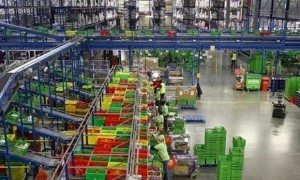Ocado finally makes online grocery retail work

UK retailer Ocado creates a viable online grocery service by reinventing operations around online-only grocery retail.
 Widespread access to digital technologies promised customers the convenience of grocery shopping without having to go to a store, pick items from store aisles, pack them and take them home. Unfortunately, this service often came at the price of long and/or unreliable delivery windows, costly delivery charges, unwanted substitutions or stale fruit. Many customers also realized they preferred to select products from the aisles of a store that they were used to rather than to browse and search products in an unfamiliar online store.
Widespread access to digital technologies promised customers the convenience of grocery shopping without having to go to a store, pick items from store aisles, pack them and take them home. Unfortunately, this service often came at the price of long and/or unreliable delivery windows, costly delivery charges, unwanted substitutions or stale fruit. Many customers also realized they preferred to select products from the aisles of a store that they were used to rather than to browse and search products in an unfamiliar online store.
Over the course of its 15-year history Ocado, a UK pure-play online grocery retailer, managed to change the balance of the costs and benefits of the customer proposition and became the world’s largest online-only grocery retailer. For the first time in 2014, Ocado captured enough of the customer value it created to operate profitably despite the headwinds of a price war taking place in the UK supermarket sector [1]. As the scale of the business grows and as Ocado develops ancillary revenue streams, it is well positioned to continue on its path of a clear winner from the digital transformation of grocery retail.
How Ocado creates value
Ocado’s heavy investment in the user interface has gone a long way to create a user-friendly and personalized shopping experience providing easy access to items the customer bought in the past or may be interested in buying. For many, the ability to find and compare items and to identify deals has made up for the attraction of choosing items from supermarket shelves.
By designing its operations around a pure play in the online market Ocado shortened its supply chain and was able to concentrate its fulfilment at two major fulfilment centers each of which is now shipping about a million items a day [2].
its operations around a pure play in the online market Ocado shortened its supply chain and was able to concentrate its fulfilment at two major fulfilment centers each of which is now shipping about a million items a day [2].
The scale benefits in fulfilment were augmented by the company’s heavy investment in proprietary technology and data analytics and continuous improvement of its fulfilment and transportation network (the company employed 550 developers in 2014 and boasted that its van routing software made 3m calculations a second to optimize the routes of its van fleet [3]). This allowed the company to succeed in containing the high costs of operations associated with providing timely and reliable service while offering a range of products larger than its traditional competitors. [4]
Not having to bear the costs of store operations also allowed Ocado to offset, at least in part, the cost advantage of large retailers who could negotiate better terms with their suppliers. In fact, Ocado is already matching Tesco on a broad range of its popular products! As the scale of Ocado in the UK grows, this advantage will continue to diminish [5] and the threat Ocado is posing to traditional retailers will likely increase.
How Ocado captures value
With its strong value proposition Ocado is attracting increasing numbers of customers willing to hand over to Ocado both the retail margins on its products as well as delivery fees ranging from free to £5.99 ($9.24) depending on the value of the order and the time and day of the delivery. Customers can also purchase a range of annual passes that qualify them for free deliveries on some or all the days of the week. [6] Just as traditional retailers, Ocado also benefits from supplier funding for product promotion.
The road ahead: online-grocery-retail-as-a-service?
While competing in the UK online grocery retail market, Ocado has developed significant know-how on grocery retail user interfaces as well as the hardware and software needed for effective fulfilment and transportation. Access to this expertise and the physical fulfilment network may be very valuable to other grocery retailers looking to launch or improve their presence in the online grocery retail market and Ocado is currently developing and marketing a platform that will give grocery retailers access to these resources for a fee based on capacity.[7]
This widely different business model serving B2B customers appears to be a key component of Ocado’s future strategy and global expansion and it will be fascinating to watch whether Ocado will be able to create and capture value in this market just as well as it has done in serving UK’s households.
####
[1] Ocado delivers first annual profit, The Guardian, 2/3/2015
[2] Ocado Group plc annual report & accounts, 2014
[3] Ocado Group plc annual report & accounts, 2014
[4] Unilever stumbles amid online grocery fees, Financial Times, 8/12/2015
[5] Ocado delivers first annual profit, The Guardian, 2/3/2015
[6] How to avoid delivery charges, The Guardian, 11/30/2014
[7] Q&A: Paul Clarke, CTO, Ocado; InformationWeek; 6/16/2015



The market for online grocery shopping has definitely a huge potential, perhaps comparable to the impact Amazon had on bookstores a few years ago. However, I think it will be really interesting to observe the different companies entering this market (there are many). Especially the existing e-commerce giants and technology companies like Amazon or Google will try to dominate this market, too (http://www.businessinsider.com/google-and-amazon-enter-food-delivery-2015-9). Although these companies may have enough cash and power to enter the market, I think it will be challenging, since fresh food requires many adjustments such as new local distribution processes.
This is indeed a very promising space. In terms of creating value to consumers, there is no doubt that an online grocery model is the way to go in the future. Fighting with the giants in this space (Amazon, Google) will be a challenge as David pointed out. I believe another big problem is food delivery in non-metropolitan areas. Because of fleet utilization issues, it is extremely difficult to deliver to certain suburbs or rural areas. The U.S. is generally more scarcely populated than Europe so this is something to consider. Perishables also pause huge challenges. As things stand we waste close to 1/3 of fruit and vegetables before they reach consumers. Online grocery delivery can improve on this process by reducing the number of middlemen in the supply chain. This shortens the time to delivery and brings down costs and waste. But once again, if you eliminate the middlemen then you run into fleet utilization issues. Startup company FreshRealm (http://freshrealm.co/) is really young in this space and attempts to achieve these two goals (utilization, direct delivery) through a reusable vessel for fresh produce. Meal delivery (e.g. Blue Apron) are also competing in this space, although with different business models. I am excited to see how things evolve.
It is very interesting how many players are trying to crack this area and how the e-commerce, delivery system and brick&mortar will interact in the grocery shopping area going forward.
Is there a chance that Ocado will enter brick&mortar as some of the digital players did before (for branding purposes, or to serve as pick-up locations in sparsely populated areas)? Or is there a chance that Tesco will acquire a better digital delivery platform and will launch a price war against Ocado?
Thank you for a new piece of information, Vlado!